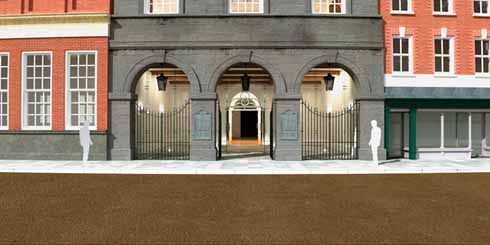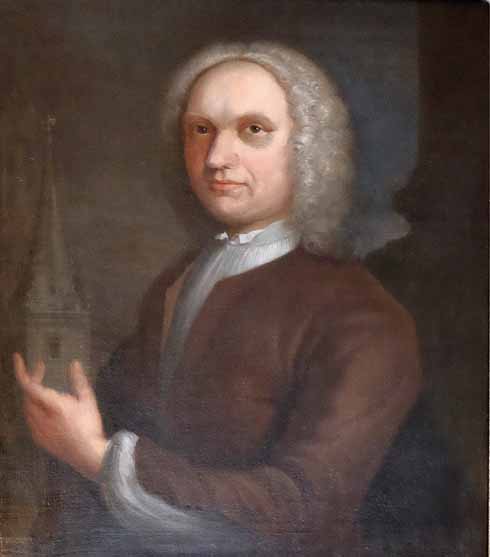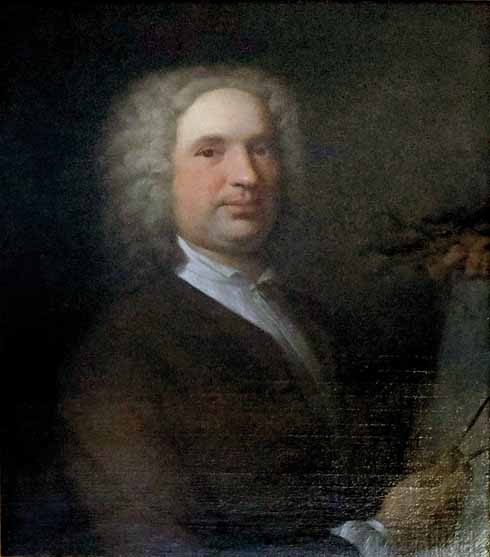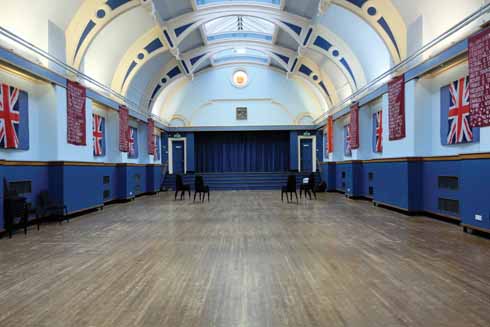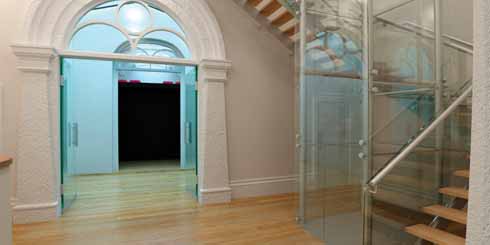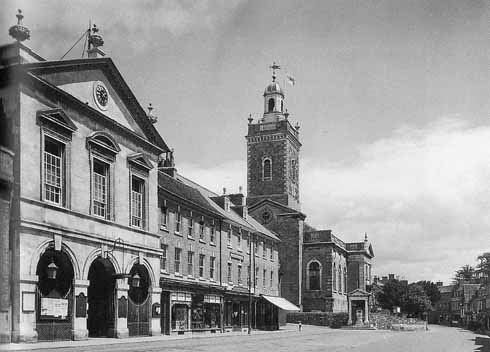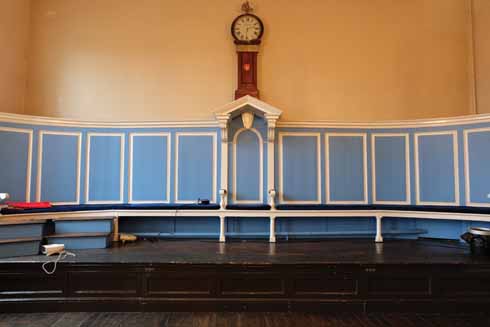What would the Bastard brothers say?
Louise Bliss considers the past, present and future of the Blandford Corn Exchange
Published in May ’16
What stories would be told if only paintings could talk? John and William Bastard’s recently restored portraits hang proudly on the wall of an important building that they designed and built in the Georgian market town of Blandford Forum. That building is the Corn Exchange, and it belongs to the people of the town. It is identified by its grand Portland stone, Palladian-style façade. The Corn Exchange has been at the hub of Market Place for nearly three hundred years. A gem of an engraving can be found if you look carefully in the upper part of building’s façade: ‘Bastard Architect 1734’. John and William Bastard were instrumental in rebuilding much of the town after the devastating fire of 1731.
There are exciting and radical plans in place to take this 18th-century building into the 21st century. The challenge is not only to secure funding but to restore the grade 1 listed building sympathetically, while trying to retain its historical features. What would the Bastard brothers say about these proposed changes?
Three buildings make up the Corn Exchange. The first building is the town hall, with a loggia on the ground floor called the Shambles. The name originates from a place where animals were slaughtered or stalls sold goods, originally meat. An ex-courtroom and Mayor’s chambers can be found on the first floor. The second building is the main hall, which is the area referred to as the Corn Exchange. The service accommodation to the hall, with the town council offices above, is the third.
Since the building’s completion in 1734 there have been several developments. In 1825 a small extension was added and in 1848 a market house built, but within ten years it became obvious that the space allowed for the market and public needs were not enough, so 1858 saw the market house demolished to make way for the current Corn Exchange hall. This was a stand-alone structure at this point and not linked to the town hall. It was during the 1891-93 amendments that the buildings were finally linked; additions such as a stage, storage rooms and kitchen facilities were introduced during this period, too. In 1990 the town council relocated its offices to an area above the storage rooms.
Due to the piecemeal nature of these changes, the Corn Exchange has a disorganised floor plan that restricts its being used to its full potential, and it lacks modern facilities. Archived minutes of town council meetings show that there was not always enough money in the pot to finish alterations to the building to the required specification. This has led to historic issues that are still causing problems: for example, the different floor levels make disabled access extremely difficult and in some cases impossible. Damp is also an issue. The stage at the back of the main hall, although linked, is technically another building, hindering theatre and musical performances. Catering can prove a challenge at times with the current kitchen arrangements.
The town council has put together a forward-thinking and courageous plan that champions an integrated plan to help solve some of the basic issues and to enable a solid, sustainable future for this community building. This comes at a price. It will be important to try and raise the full funds from the start to prevent history repeating itself. It has taken a long time from the initial ideas in 1996 to securing the full planning and listed building consent in 2014. Many different bodies – English Heritage, the local planning authority and other statutory consultees – had to be involved.
An impressive glass enclosure of the Shambles area is a feature of the new plans; the glass will open up the space to give the illusion that the area is bigger than it is. It will include a box office and a state-of-the-art glass lift for disabled access. Telescopic raked seating will be a key feature in the main hall. Final finishes and colour schemes are all details that are required to be confirmed with English Heritage and the planning authority.
Hidden behind the studwork in the main hall are some Victorian tiles, possibly Minton, which are not produced any more. One idea is to glass-frame sections of the existing tiles to create a focal point for all to enjoy and to protect them for the future. Other proposed facilites include a sprung dance floor, full blackout, improved acoustics, a new stage, sound equipment, hearing loops and specialist lighting, digital projection facilities for the showing of films, new backstage facilities and dressing rooms plus kitchens to both lower and upper floors.
The town hall upstairs has doubled up as a courtroom in the past and the existing magistrates’ bench will be retained. The enhancements to this area will provide an excellent place for parties and receptions. The original upper hall arch will be re-instated. The rear three windows will be fully restored, so once again the front and back of the building will be in harmony. Permission has been given for the current council offices to be demolished. The engraved wood panelling detailing past mayors and freemen of the town will be removed and used in the new council rooms. The new offices will flow beyond the Corn Exchange hall.
The Corn Exchange is hoping to receive the biggest injection of money in its history. There are plans in place to raise the money for this community building. One of the fund-raising avenues is the Friends of the Corn Exchange community group. It was born from the desire of local people who kindly donate their time and energies to preserve, improve and regenerate the Corn Exchange.
Helen Cooper, chairman of the Friends… group, says: ‘Standing as it does in the centre of the town, the Corn Exchange is the obvious location for a community hub and the focus for artistic and cultural life in Blandford and the surrounding area.’
When regenerated, the Corn Exchange aims to provide a multi-purpose venue for people who want to enjoy a variety of events: musicals, plays, concerts, films and art exhibitions. With central and local funding constantly being squeezed for projects like this, local groups like the Friends of the Corn Exchange are vitally needed. Events and what’s new and exciting in Blandford will be communicated through the a new website, posters and social media. The group would welcome any newcomers to the campaign; any help, no matter how big or small, would be appreciated. No particular skills or experience are required, just a like-minded attitude to want to help improve the town.
Blandford Forum is often described as one of the best-preserved examples of a Georgian town and whilst this is still largely true, this historic town is in need of some love and attention that will see it through another few hundred years. Now it is entering a new and exciting era because there are other historic buildings in Blandford Forum, all with their own support groups. They come under the umbrella of the organically grown regeneration project and include the Friends of the Corn Exchange, the Cupola Project and the Blandford Museum. They also have the support of other local friends like Forum Drama and the Blandford Fashion Museum. These community groups are trying to improve the facilities and experiences for the people of Blandford as well as encouraging others from far and wide to come to Blandford Forum for their leisure and cultural experience. More people choosing to visit Blandford will be beneficial to current retailers and may encourage new shops and business to open.
The Corn Exchange has played a major role in the town as the place from where county, country and worldwide news has been announced such as royal births and deaths and the two world wars. It has been and still is a place to meet, work, play, celebrate and remember. It has seen many changes since the days of John and William Bastard, but it would be nice to think that they would approve of the new plans for the building with their name on it, and that they would enjoy seeing the building crowded with people having fun, learning, socialising and being entertained. ◗
❱ For details of Friends of the Corn Exchange visit facebook.com/BlandfordRegeneration, contact group chairman Helen Cooper on 07753 808736 or by email at helen@heraga.co.uk A video clip of plans can be found at www.blandfordforum-tc.gov.uk/What’s On/Corn Exchange Regeneration.html
